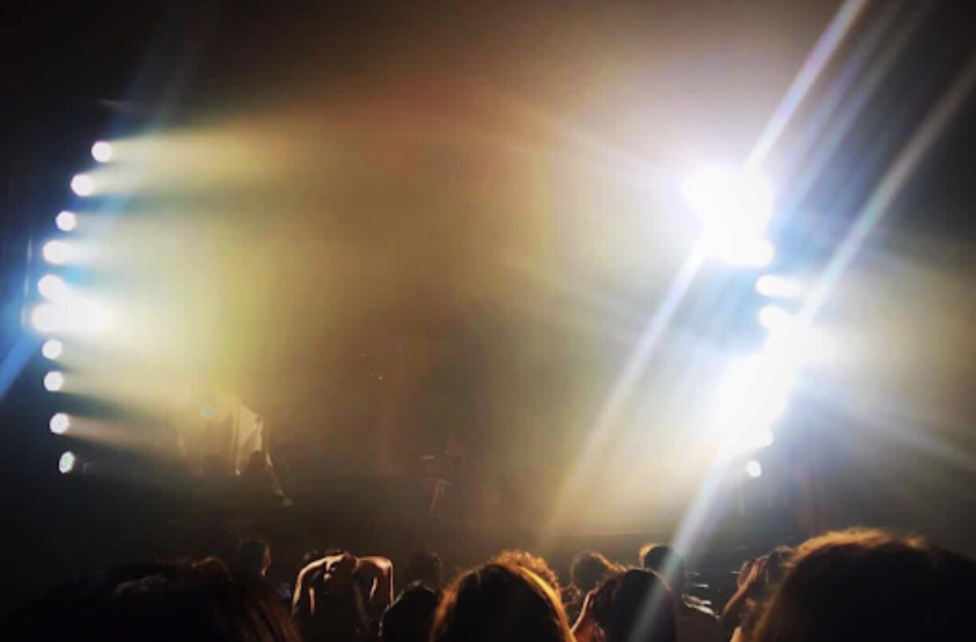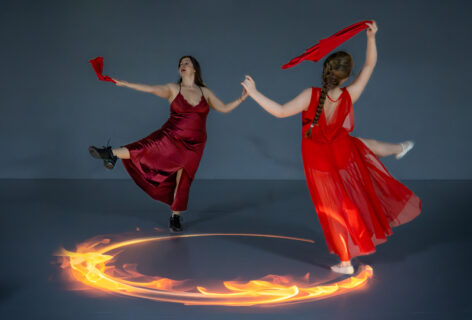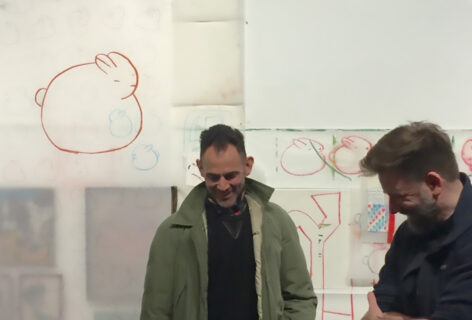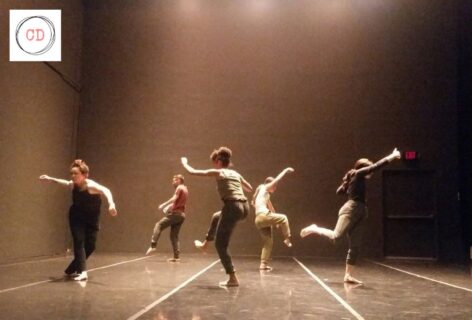(echoes of orders over the bar, the typing of a laptop at a neighboring table, a rack of dishes being brought to the kitchen. emmagrace is already seated at the table when jonathan and rudy arrive. an exchange of hugs and kisses after a long time since, and a round of orders before settling into our seats)
[all capitalizations have been edited to lowercase except for the select words. punctuation has also taken an individual approach to speak to the informality in the density of our language]
jonathan gonzález: i am here (sitting with a beer) and you, and rudy gerson — the other collaborator on the work.
emmagrace skove-epes: yes, excited to be here with you both! to begin by being upfront about how we conceived of this conversation, jonathan, you and i have a history of talking about work together, making work together, dancing in other people’s work together, dancing in each other’s work, as well as curating a Movement Research festival with Zavé Martoharjono, which addressed collective labor in art making and organizing. while my primary connection to Lucifer Landing I and II is through knowing you and your work, this conversation is going to address art-making that includes the work of so many people. can we start by naming all of those people as a way to acknowledge the collective labor that went into Lucifer Landing I and II?
jg: absolutely. for Lucifer Landing I,
rudy gerson – lighting designer and dramaturg
rena anakwe – design team, lighting designer, and musician
pamela liou – designer and filmmaker
nadia tykulsker – administrative partner
i moved between design roles, builds of the architecture, and performing/choreographing the sunday sessions performance.
the other collaborators who became more apparent to an audience in the second act at Abrons Arts Center (Lucifer Landing II) were musicians:
Jeremy Toussaint-Baptiste
Johann Diedrick
Rena
GENG as primary musicians collaborating with me on the libretto.
this includes the five student musicians of Studio 57:
Anna Yeh
Roman Lafia
Tiyon Hargrove
Austin Celestin
Taja Graves-Parker

Lucifer Landing I, MoMA PS1 Sunday Sessions performance, photo: Maria Baranova
ese: i’m curious if there was blurriness between roles and if so, how that played out in the collaborative process. jonathan, you and rena have both been in each other’s work for some time, and the two of you here, rudy and jonathan, are collaborators as well as…
jg: partners!
ese: partners! (whispers: jonathan and rudy are now touching hands, palm to palm, across the table).
rg: we’re also creating a force field between us!
ese: oh! right!
so my initial curiosity about potential blurriness stems from knowing about these long-standing or multi-layered collaborative relationships. though of course that blurriness can happen in so many different contexts of making work and with different degrees of familiarity or lack of familiarity in working relationships. jonathan, do you call yourself the lead artist of this work? Lucifer Landing I was such an immensely immersive environment. i experienced so many elements coming from all different directions at once that bled in and out of each other in a kind of kaleidoscopic or fractal relationship: the rapidly shifting sound-responsive lighting, the tapestry of the soundscore itself, which intermittently drowned out your amplified reading voice and then revealed it, the film projection onto triangles of material suspended between these central axes of wooden beams which formed a small dome you all had built. that smaller dome resting on top of a floor of compost within MoMa PS1’s expansive VW dome. and then the warped extensions of projected images that slid their way into the crevices of the larger dome, flickering both light and shadow onto the sky-like ceiling, and all of the surfaces enclosing us. it was wonderfully disorienting, and amidst that disorientation, the lines of whose work was whose, were not legible to me. knowing you and having been exposed to the way you work in certain contexts, i wondered if that was intentional.
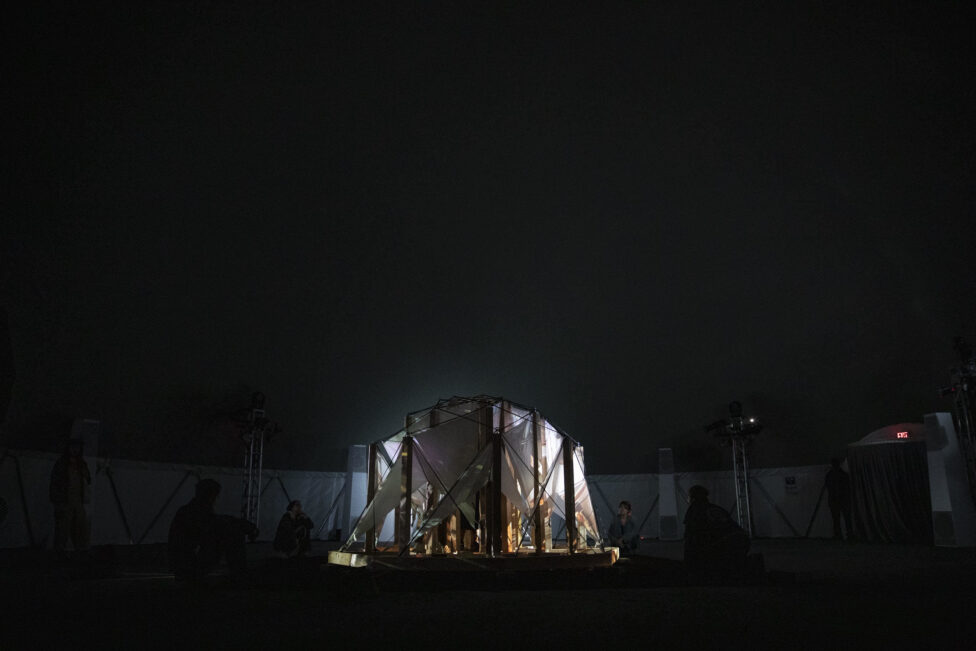
photo: Maria Baranova
jg: sole authorship feels uninteresting. we are thinking about the choreographic practices being the movement material, negotiations of people and all design/theatrical elements. we are trying to craft a creative worlding in which everyone can be in the room in their fullest capacity and push the rigor of the work to be both comprehensive and innovative. this is effected by how many players are in the room. it is not syphoned into an authorship that is mine although it is initiated through my direction which includes my research and initial endeavors. with each work there are collisions. with this work, and most all of my works to date, there is an extensive team of folks who bring something unique to the room. everybody is requested to be dexterous in their way of approaching their role as plural for a kind of making that can surprise us formally, and aesthetically. with that, the flexibility to move between roles was something that happened organically, just like the quantity of people in the room was something that happened organically. these people were invited by me because we were already hanging out and talking a lot. i breach these commitments with people and then we see where they develop and they normally just spiral. sometimes it doesn’t work and they spiral out, and people did leave the process too! the creative process produces those kinds of spirals, and the work was changed and effected by all of these collaborations.
ese: in my experience as a mover and vocalizer in past artistic processes that you have initiated and guided, you’ve been there to direct and to make decisions when decisions needed to be made but also you’ve been there to not make decisions when decisions needed to not be made. both are important. it’s felt like the container of your vision is both specific and expansive, grounded in specific research and specific vision, but that the spiralling you’re describing is part of the research and vision, not a detour. the expansiveness and specificity don’t feel like opposites, in fact it feels like they rely on eachother somehow. and that’s applied too, to the ‘boundaries’ between ‘different’ artistic media.
jg: it’s very hard work. and it also has to be with the people that are interested in putting themselves on the line to make the work which is also very laborious. but it’s demanding a way for us to imagine collectively through praxis.
rg: i just read this passage in this book Forbidding Colors that jonathan just picked up. there’s a passage about aesthetics and beauty and ethics that brought me a lot of clarity. a critic is talking about the life and work of this author-character. they point out that the infamy of the author is from a group of people who have untethered the conceptual commitments of aesthetics and beauty to ethics and have supplanted it with a sort of individualism — that’s also tied to class. i am relating this to our thoughts around art making and individualism and capitalism. it brought a lot of clarity because the beauty and aesthetics of this work is always informed by the ethical urgency to make the work. all the questions we ask require forms of relational demands from the people making the work and the people who are intruding the room as audience members to see the work. i would say that there are a lot of complications that come from trying to bring a bunch of young folks in New York City into rooms to make work over the course of a year; to actually dialogue with one another while arriving completely incapable of dialogue because of life and the present condition of being stripped of resources. you are either given resources and then having them taken away or given resources but not the ones that you really desire or you’re just so preoccupied with the fact that some people have more resources than other people. it is a group of people all finding that out in real time and then all really being committed to the work in our own way and not actually agreeing on what the thing is. if you ask everyone in the room to write about the work or to speak on the work it would all feel very different. there wouldn’t be one work. that’s why it’s one part painful, because it’s a failure, and then the other part is humbling because we all know jonathan can craft a space in which all these things can coexist.
ese: to acknowledge the vast differences in the journeys artistic collaborators take to get to the same room in which the work is made, and then on top of that, your different relationships to what is being made and ideas about what the work is, and to address those differences and potential frictions as artistic collisions in the process seems, not only honest and generative despite its challenges, but if I’m understanding correctly, that dynamic itself reveals the ethical urgency of the work as an actively interpersonal process of imagining collectively. that there is an ethical imperative in engaging in the difficult process of meeting and creating with each other and collectively imagining, not idealizing that meeting, but committing to that hard work of coexistence amidst disagreement or difference in perspective. it makes me think of how within certain sectors of the performance field in which there continues to be a lot of talk about how the process always shows up in the “product” and valuing “process over product”, that there are still so many directors and choreographers within those same sectors, who unconsciously and indirectly ask people they work with to compartmentalize or compromise aspects of their identities in the name of getting the work made without a certain degree of discomfort on their (the choreographer or director’s) part, or friction. perhaps because the wading through that discomfort and friction is perceived to be incompatible with the time-sensitivity of many performance timelines. as you said, commitment to process takes a lot of work. i admire how you are actively and intentionally practicing. hearing you both talk about the process, makes me reflect on my experience of sensing that many aspects of the process were being highlighted and worked with as as material within Lucifer Landing I, despite none of the collaborators being visible, and despite the audience not being privy to the process of your creating.
rg: how did you feel that? because i’ve never seen the work outside of making it, so I don’t understand what it would be like to see the work for the first time.
ese: sure. when i say sensed aspects of the process were being highlighted, i mean that i wondered about it. but sensing and feeling is a part of it too, even if sensing and projecting get blurry. Lucifer Landing I provided space to ruminate on that blurriness because of how much opportunity to make individual choices I was given as an audience-participant. but to speak to your question, i think the fact that footage of the actions of the construction of the smaller dome which was used in both Lucifer Landing I and II, were then projected onto that finished dome, revealed parts of the physical labor of the process: an aspect of the ‘product’ was the literal projection site of the process it took to construct that product. on sunday, myself, and others who were in the VW dome at the same time, were wading and climbing our way through the smaller central dome, so we got to touch all the physical materials that i imagine you all spent a lot of time with. to find our way inside the smaller dome, we had to physically problem solve- weave and squeeze parts of our body through materials that had been woven and squeezed together by rena and pam and jonathan and perhaps other collaborators on the work. the act of having to problem solve to get in and through that dome, sparked my imagination about the collaborative labor and collaborative vision it took to produce that dome- it was a way of interacting with and listening for the physical labor that took place in the process and expressing curiosity through movement. for me, something about being able to touch materials, opens up a potential for a different kind of learning about the potency of the materials, it feels like you can listen to the materials while imagining the process that took place with and around them. and i know you, jonathan, have a longstanding relationship to some of the materials.
but also, i’m thinking about entering the VW dome at MoMA PS1 and feeling so enveloped and saturated- there were so many elements to process with both as much time as we wanted, because you allowed people to remain in the dome for as long as they desired, but also, because of the coexistence of so many elements that were constantly “interrupting” eachother, it felt impossible to track any single element without shifting focus to another and then another. it felt like there was cohesion in a sort of dissonance – not that the individual elements were actually dissonant at all, but i remember experiencing a feeling of dissonance in my body, as well as the sensation of being wrapped or held by the weaving together of all of these elements. the saturation in that particular multiplicity felt essential.
i’m curious too, about how rudy, you described the audience as intruding the room. in Lucifer Landing I, you were allowing people to enter the dome whenever they wanted and for however long they wanted. that is immensely generous. and also-
jg: anxiety-producing! (for the audience).
ese: ha! and anti-institutional. yeah, potentially anxiety-producing in how it puts the onus on the audience member entering to answer: how am i going to contend with this? for how long? what am I going to sit with? what am I going to avoid?
jg: we deal with these important questions as people who are navigating the stage. we also deal with these questions as people who are dealing with the afterlife of slavery and people who are dealing with the situation of displacement. people are asked to refuse, to refuse consumption, to refuse the exploitation of neoliberal ideals. the work somehow extricates the institution from being a proponent or issue or force that inflicts violence upon artists and upon projects of diversity and upon the neighborhood in which it stands. we are also not clean of the experience. we have entered into their territory and decided to produce commentary about space and identify that space. Lucifer Landing I is responding to its own site – to the work of CHARAS with a dome crafted with the utopian strategies of Buckminster Fuller. which makes that work particular and purposeful and site specific…(and also reveals how we are deeply entrenched in working in a capitalist space) – there is no way to separate ourselves from that space as artists who are working in New York City. it would be too idealistic and naive – collaboration does not absolve us, or remedy the measures. but to imagine how to be inside of a dispossessed site like being inside of a dispossessed body with a sense of play and criticality that will deflect ease of consumption and collectively push the boundaries of an institution, and the desired optics attached to our work was the creative task.
ese: i’m thinking about how you wrote in the program notes about the absence of you as an artist in Lucifer Landing I, and how when i went on sunday, you were giving a 2+ hour live recitation of Toni Morrison’s writing from the basement of MoMa PS1 that was amplified throughout the VW dome as well as MoMa PS1’s courtyard. while you didn’t make an “appearance”, you were continuously present.
rg: it’s funny to hear that – it didn’t feel like a 2 hour recitation, but it definitely was a 2 hour recitation. i got to hang out “backstage”, i think i took a nap, i don’t know what happened. jonathan was reading this book, Toni Morrison’s “Playing in the Dark: Whiteness and the Literary Imagination”, that we had been reading, you had been reading, i had been reading…
jg: yeah, eg and i read it together for the first time in grad school.
rg: ok, so many of us have been reading for some time now. so yes, it was a recitation, but it somehow felt like a thing that had been done before, a thing that should be done.
jg: well this gets back to what eg said in her writing in talking about the physical materials in the work and their recirculation, like the tarp that we laid down in Lucifer Landing I that had been in other works, i’d worked with it for years. we are inspired by the things that come into our vernacular and all of our cartography as people who are making work. and also queer people who are making their own realities and people of color who are finding ways to survive. we have strategies in which we exist in the world. our strategies repeat themselves and we overlap in terms of the ways we pull inspiration from other works. there’s a recirculation of materials that have become reformatted and become somehow present or meaningful or necessary. the Sunday Sessions, or final day of exhibition at MoMA PS1 marked a performance and recitation I made over the loudspeaker from the interior of the museum riffing on Toni Morrison’s, “Romancing the Shadow”. Toni Morrison was necessary. this chapter is talking about what it means to be in love perhaps with the shadow. what it means to be dispossessed inside a literary and imaginative cannon, and the complications of refusal. i wasn’t able to understand this in the text when I read it the first time but I can now, especially within the context of a museum or a stage. where I felt the domineering exploitations of a museum institution requesting my presence and my visage to be used as a body. so, i was like, “OK, y’all… how do we salvage this work?” one, because the architecture that we built was so important, it had a planned life after Lucifer Landing I, particularly as a greenhouse at Abrons Arts Center.
[Interrupted by last call at the bar, Rudy gets up to get beers for us all].
ese: you were talking about the life of the dome you built, now having a life as a greenhouse.
jg: the dome having a life after that first site, as a greenhouse- always with the endeavor of wanting that to be a functional thing. we busted our asses off to learn how to build it. and that was a desire before we knew what exhibition space we’d be in. i wanted to learn, with the people who are close to me in this city, how to produce something together, to share skills, how to build something. these skills are part of the inequitable reality and one of the most important choreographic things i learned in this process was how to use a hammer and a screwdriver, to cut wood, and produce a home. to know how to first articulate those things as colonial and patriarchal consumed by this idea of legacy, but then to produce amongst each other in the word and name of CHARAS, to try to imagine what it means to produce some kind of interruption where we who live under racial capitalism could be able to share skills, and that’s what the future of the dome entails — not just a sculptural work to rot in storage. so P.S. 1 happened as a way to critique their dome and their institution, and their institutionality – how they deal with artists, how they think art should be valued and the toxicity around that. using Toni Morrison was a way to return to a time, and to think about it now. Toni Morrison is saying things that i could never…i mean i did riff around and improvise through that reading on sunday, but there were things in this text that i am only beginning to arrive at as a radicalized person in this world and as a person who imagines surviving and being an artist in this world.
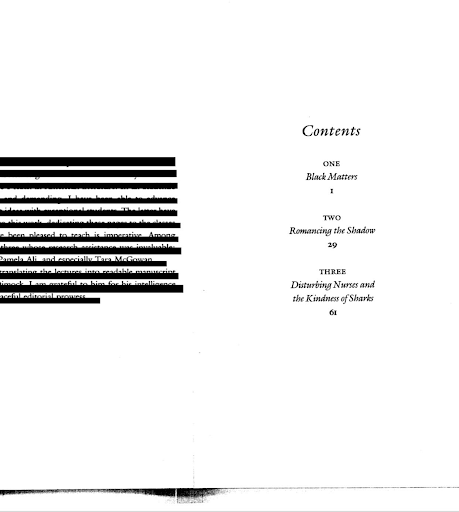
ese: i didn’t know it was that text as you were reading it- i wasn’t able to identify it in the moment, despite having read it before. it was probably in a program somewhere, but i tend to be someone who does not read programs before going into a work, i tend to read them after. i recognized that i had previously spent time with and chewed on the words you were reading, there was a resonance and familiarity. but it wasn’t until i was in the process of writing about Lucifer Landing I, and i reached out to you to ask, “What was that text? Can you send it to me, so that I can weave it into this writing I’m doing about your work?”, that i realized where i knew it from. though your presence was a point of felt connection for me, because as you said, we read and discussed this text together in a class in grad school, and despite not initially recognizing it because of how it was differently situated within and contextualized by Lucifer Landing I, it was also not the first time i’d heard your voice reading that particular chapter (“Romancing the Shadow) of Toni Morrison’s “Playing in the Dark”. she has one quote that i’m thinking of, which i’m not going to remember exactly, but she’s talking about the impossibility of going intact into the (artistic) work.
(later, emmagrace looks up the quote in the pdf jonathan sent her. the quote she was thinking of is from p. 4 of the chapter “Black Matters”. it reads: “… imagining is not merely looking or looking at; nor is it taking oneself intact into the other. It is, for the purposes of the work, becoming.”)
…and i think that feels relevant – whatever kind of “intactness” an institution would presume or expect of an artist entering into that institution and making work, and specifically we’re thinking about and talking about you, jonathan, as a black artist entering this white institution and very specifically commenting through your work on the expectation of you and your identifiers being attached to the museum as a certain kind of…
jg: visible entity.
ese: yeah, visible entity, and “cultural boost” for the institution. hearing those words in your voice paired with the absence of your visible physical presence or the visibility of any of the collaborators, really made me as an audience-participant, have to take in the site in a way that i’m not often given the opportunity to do within the restrictions of time that generally accompany situating work within institutions. to really take in all the small details of the landscape, the density of the air, the energy, all the small but significant details that are part of the institution and all it represents, thinking through and wondering about its history and feeling the reverberation in my body of all of that information and all of those questions. feeling into that reverberation was aided by the experience of being literally vibrated by the immersive multi-directional/surround sound which was also connected to the lights rapidly brightening and dimming.
rg: yeah, sound-responsive lighting. a big conceptual gesture of and underlying questions of both Lucifer Landing I and II had to do with the human and the non-human, and that’s more than the corporeal body and the inanimate object, but actually thinking about the humaneness, and human-ness, and humanity as a conceptual container. many things get humanized and other things get de-humanized or non-humanized, and so trying to animate the relationships between all of these human elements and material, and conceptually thinking about the non-human and how to form some human-ness with them.
jg: you know, i’ve done this with other works – part of my directorial role is that i accumulate a very large kind of research space that involves talking to folks and also reading interviews and other things, in this process that incorporate black geographic text, that encompass ways of thinking about maroonage, histories of land use as they relate to people of color and racial capitalism. my work is shadowing farmers, looking at landscapes in the U.S. – we made a trip to a slave plantation and to different national preserves, we were looking at content and the space and animal life and how ways of looking at animality, like larger cultures of animal reality, like biodiversities and their neglect under the realities of our contemporary life which is dictated by powers of man which are always dictated by the Western ideology of white male supremacy and how those spaces view other biodiversities as points of utility and spaces of extraction. how that point of extraction, which is all other forms of animality and landscape and ecological terrain, are deeply linked to the black body. that body of many bodies which has been dehumanized and has been located equally in the form of violence and extractive use that the land has. and then trying to animate in both Lucifer Landing I and II, how the architectural and the abuses that have been inflicted onto it, are both representations. different texts by Sadiyah Hartman, Hortense Spiller, Fred Moten, Frank Wildersen, Katherine McKittrick, Jared Sexton, Zakiyaah Iman Jackson, Sylvia Wynter, Mabel O Wilson, Mario Gooden, and the work of so many black abstractionists thinking through this nexus will tell you how these corporeal and inanimate bodies do not have full autonomy, or perhaps none of us do, in the ways that they access space and because of that they will always be in some kind of de-collatoral with the earth.
rg: there are multiple types of anti-black action that descend upon a body and descend upon a space and descend upon conceptions of history and descend upon understandings of architecture. we were reading “Lose Your Mother” by Hartman, which was one of our many guideposts. and Katherine McKittrick has a wonderful text that deals with black geographies, deals with maroonage, and what Moten would call ante–
jg: or things that live alongside, not associated with the anti.
rg: yeah. thinking about all of that, you have to reject canonized and industrialized notions of the use of technology in a performance space. and the use of a performance space as a performance space. we don’t use the word “decolonize” in the rehearsal room, but what…
jg: no, we don’t use that word.
rg: what some would call a “decolonial space”. and all these things are happening simultaneously which is why we’re all complicit to participating in the space, because we know it’s also a “decolonial act” as understood by others. so back to thinking about the lights. jonathan is not the performing body, because there’s no supremacy of “the body” here. also Sylvia Winters’ “The Representation of Man”. thinking about personhood and thinking about opera. if you think about the form of opera as being over-representational in its most gilded form, then jonathan is the antebody that came before the opera, which is always being replaced by various archetypes. the stage became the body because it contains an infinite number of bodies which are all unimportant actually to the form of opera. so in Lucifer Landing II, the lights became necessary to sing the songs or to perform themselves because they are always already performing in a utilitarian sense that is tied to a history that we don’t talk about.
jg: yeah, the architecture’s attached. one, as a departure from the choreographic and architectural through notions of an africanist cosmological and spiritual practice — or how to play with the illusion of theatricality and the notion of blackness as excess or ritualistic? which also is linked to why I work with people because I enjoy communication and congregation in the way that things get built, the ways we learn to be with one another in the process of being creative, which always falls in some way outside of the capitalist framework because its slippery and we have to believe in other forms of transaction. the work has value that’s somehow fucking with an essential idea of black being, spirituality, abstraction to animate the catch-all nature of a black hole. and then, simultaneously, the actual work itself, has to interrogate how the performing body exists. if I’m going to step onto that stage, or if an audience member is going to be present to my performing, how do they feel implicated in that experience? which is hard, the hard work.
ese: that implication felt so different between Lucifer Landing I and II. you, jonathan, are fully present in Lucifer Landing I in every possible way other than that we don’t see you in person- we see film footage of you with your back facing us, we see and hear and feel the impact of your choice-making within the installation, and we hear your voice amplified (on sunday only), but you do not make a visible live appearance. similarly, we see and experience the work of all the collaborators on the work, but none of the collaborators are visible in the work. we as audience-participants have so many choices – how long we stay, where we go in the space, whether we climb through the structure of the dome or not, what we choose to give our attention to or withdraw are attention from, which words of yours we listen to and how those words impact our further choices- these choices are directly tied up in our implication. but then, in Lucifer Landing II, for the majority of the piece you’re the only person on stage, but you’re mostly obscured- you’re in darkness, or the many other objects on stage are spotlit while you’re in shadow, or we as audience are partially blinded by bright lights shining directly at us, so perhaps you get to see us more than we can actually see you. we as audience members of course still have some choices but are likely playing along with the unspoken “rules” of the theater whether or not you want us to. we stay in our seats, and we most likely read the text you project, and then I imagine, most of us listen to you, and watch you or strain to see more of you regardless of how much you choose to be visible. because you’re in front of us, our desire to see you is brought to the surface differently and it provides a different opportunity for to interrogate our own complicity in the consumption of you as a performer, while also having ongoing opportunity to take in the architecture and all of its animated ‘inanimate’ parts.
rg: well, jonathan is the director and performer, but a lot of the light in Lucifer Landing II, i’m controlling manually, so i actually decide a lot of what gets seen and what doesn’t. there’s a negotiation always. i mean you, jonathan, get to decide the light in that, your mic is connected to one of the lighting instruments that you carry for part of the piece, so you get to decide the volume of your voice and thus how much light will emanate. but it’s all real time.
jg: yeah, i think it’s important for it to be on the record that what’s different about this work from previous works is that there was a unique system in which the light and sound were both responding to one another. the accompaniment of the musicians and then my live voice, was being responsive when manually dictated by rudy in the lights themselves — both in its activity and intensity to create many permutations of responses. which is how i intended to create these enfleshed tethers between my performing body and this theatrical apparatus, as somehow being appendages to my body, and then rudy and all the musicians, are active, no one’s restful. but to get back to your point, i think choreographically those are questions – how to be unseen. it was known a few months before Lucifer Landing I that i wouldn’t show up as a visage. but how to deal with my visage in Lucifer Landing II…i’m not interested in being encased in an illuminated spotlight unless there’s a conceptual proposal behind it, but then how do you find interesting ways to find refusal. if refusal repeats itself it becomes easy, then you are already captured.
ese: the live manipulation behind all of the objects- jonathan’s voice controlling the hand-held light, many of the musicians playing live from the balcony behind us where we can’t see them, rudy controlling the all the other lights, the descending of the drum machine- you as people are tied intimately, as you said, tethered, to these objects regardless of what we see or don’t see in Lucifer Landing II. we, as audience may take these objects and their actions for granted as “tricks” of the theater- there’s still some dense conditioning we (i) have to work through, conditioning to separate out or forget the human presence behind these devices, and to buy into the tricks, strip the the objects of the human collaborators. amidst all of the connections you’re addressing between site and architecture and inanimacy, utility, and extraction of earth, animality, extraction of the black body, expectations of performance of black bodies, we as audience again, have the opportunity to contend with our implication, from our specific individual positions and histories. there were so many more objects on stage than there were humans. there was this mound of compost on stage with objects planted into it (which you confirmed for me was a mound of compost)… and i think in particular it’s presence, did a lot to open and shift my perception of the other objects on stage and their humanity, their humaneness, as rudy was talking about..
i felt a humanity behind all of these objects, in a way that again made me wonder about the specific site of The Playhouse Theater at Abrons and its history. that site is more than that theater, it obviously has a much older history than the theater itself. knowing that you have been learning about farming and working with compost, and seeing this mound of compost on stage (which you confirmed for me was a mound of compost)…
rg: could you tell it was compost just from seeing it? before you were blinded by the lights, did you catch a glimpse of it? i guess you came into rehearsal, so you saw it under different lights.
ese: right, prior to the performance, i saw it under work lights. it looked like dirt, but i feel like the ‘end product’ of compost has a texture to it that’s different from other dirt- you can see and feel how it’s been worked through by human hands. maybe my perception would have been really different, had i not known that you’ve been working with compost. but having that knowledge, added for me the understanding of its presence as a substance that is very explicitly a process- it is transforming and transformed, regenerating. it is both evidence of and a product of your labor. and evidence of time passing. having it as a constant player and presence on stage, weighted and charged the space and the other objects with this reminder to consider how much labor is behind every single object on stage and in the theater, including the more mechanical lighting devices we’re perhaps used to seeing in certain theaters as objects that do tasks that we don’t see humans do.
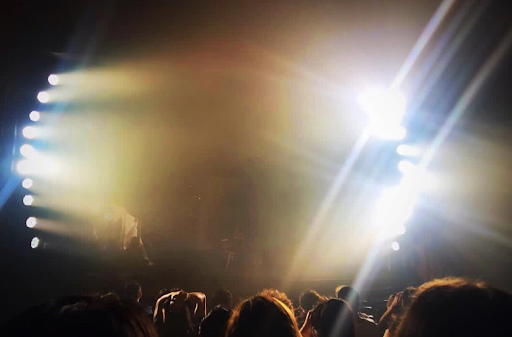
Lucifer Landing II, Abrons Arts Center, photo: Stephanie Acosta
jg: so many illusions.
ese: yes. i think of illusions as seductions of a sort. but for me they walked the line between being illusions and being sites for potential intimacy with the objects, which as you named is complex. a different type of seduction. i’ve never felt such an intimate connection with a lighting device before. i felt like i was looking someone in the eyes as i watched this one stage light take however many minutes to very gradually fully illuminate. rudy, is operating that light. jonathan, to some extent, you don’t know if or when you’ll be illuminated by rudy’s operating of the lights. i’m thinking too, about the black box as a site people think and decide they can project whatever they want onto, which ties back into Toni Morrison’s “Romancing the Shadow”.
jg: yeah, and the white box as white space. the proposal to use the proscenium theater and to “use it up” was the hard part. a lot of our time in our residency prior was spent trying to figure out how to use up the theater. so even when we were in other spaces, we were thinking about Abrons Arts Center as a specific site and MoMA PS1 as a specific site. how would an audience come in, witness, be implicated, and leave. for instance, the first image in Lucifer Landing II is the surveillance of the actual audience being recording as they sit down in theater and an odd green outfit protruding from the curtain like a breast with a nipple. this parabolic mic traditionally used to capture birds or other animals is another tool of surveillance, and a functional way to loop the audience sounds into the greater symphony. getting the light to be sensuous: soft and low, off-center, or to feel tangible and become an onslaught! to feel range with these devices that is choreographic. this range that a body can give you as a witness so that the actual body can move between proposals of shadowing, silhouetting, and all of these tropes of Black dance vernacular and minstrelsy onstage with deflection. the collisions are essential as there is no definitive stance — the work is abstract. it aims to undo the cleanliness of the stage and to wrestle with this notion of humanity under the times of apocalyptic glamour. identity is a flawed project, and so is the proposal of the human.
and then at the close of a showing, we got feedback that there was a desire, “I wanted to see you dancing”.
ese: and you’re like, “duh! of course you did!”? I mean we all want to see you dance!
jg: yeah…so when you finally get the dance at the end of Lucifer Landing II- as dillon heyck said really well in the Brooklyn Rail review, then you deal with the weight of that desire. I feel very gratified that that landed, because that was the hardest endeavor to attempt to arrive at together, in terms of activating the automated drum that is this deus ex machina that forces me to dance, getting the light to be an onslaught in which the audience can barely see my dancing body, and also physically, just trying to perform all the tropes of African-American black dance that are vernacular to the stage, vernacular to minstrelsy and vaudeville work. so trying to bring all those elements together in this moment of “ok, now you get the dance”, but the dance comes with all the implications of at least in our context in NYC of this postmodernist afterlife that we are always struggling to get out of, the dance is deeply connected to corporal experience, to subjectivity, to interiority. and the objective– we are fighting with objects. so in the way that the objects became human, the human became object, and found a way to resonate as bodies together. and that was a desire in Lucifer Landing I and II, to address that actually, the human desire is deeply fraught. and the human as an identity is a failed project which will never encompass all of us. and, we know that global warming is imminent. global death is imminent on the hands of the western ideology and capitalist endeavor. and so when we desire to imagine what it means to resonate with other bodies that are non-human, we begin to arrive at a place where we recognize our fault. and it’s not utopian, but it’s a working praxis. the collaborative group is a place where that work happens and then it continues with the audience.
ese: after building a relationship to all of these many objects on stage, the audience has to confront this objectivity of you. at times seeing you but then mostly being denied “access” to you.
rg: we all want to see you dance. it’s loud, and i can’t see you. you’re a dick. your light is up. please enter stage right.
jg: but these are all really important questions- i mean, what are we going to do from here forward? the vehicle of identity produces really reductive essentialized ideals that affect the ways we see eachother and experience eachother. and then, the stage- the apparatus that produces programming internationally. you know, i’ve been travelling nomadically trying to figure out how to make a vision for a life, feeling restless. so this work is starting to ground itself in one place, which is NYC, which is my home. this work comes out of trying to interrogate home-ness and imagining building home and how that’s all tied up in the puritannical mission. and searching for how to do it in a different way.
rg: oh shit, the lights are on. it’s time.
ese: the bar is closing.
jg: time to party. let’s continue this.
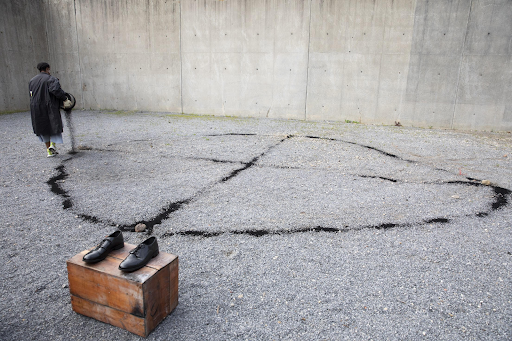
Lucifer Landing I, MoMA PS1, performer: Taja Cheek / photo: Maria Baranova

